Today, we will discuss the critical importance of aligning journey mapping with process excellence. Sometimes, organizations focus heavily on journey mapping to enhance the customer experience, overlooking the role of process excellence. But such an approach can’t ensure that improvements in customer interactions are sustainable and efficient. And we know a way out!
Our article is based on the presentation of Brenda Batista-Mollohan, Founder of Inspiring Company Culture. She used the telehealth industry as an example, but all the principles can be applied to any other industry, helping organizations deliver seamless, high-quality experiences while optimizing their operations.
Contents
Event recording
If you prefer listening over reading, feel free to watch the recording:
Understanding the relationship
Aligning customer experience mapping with process excellence can be challenging. Often, discrepancies arise because performance improvement (PI) teams work on specific initiatives and projects. That can result in the customer journey and internal processes becoming disassociated, leading to unintended negative impacts on the customer experience. Internal issues may seem resolved, but new problems for the customer may emerge. Understanding this relationship helps prioritize efforts to maximize the positive impact on CX.
KPIs play a crucial role in this process. Projects need a clear end and should not be measured indefinitely. While it is true that projects should conclude, the measurement of process improvements' impact should continue. This ongoing measurement ensures that changes are nurtured and sustained, achieving the intended long-term impact. KPIs must remain active selectively to support both process improvement and CX impacts.
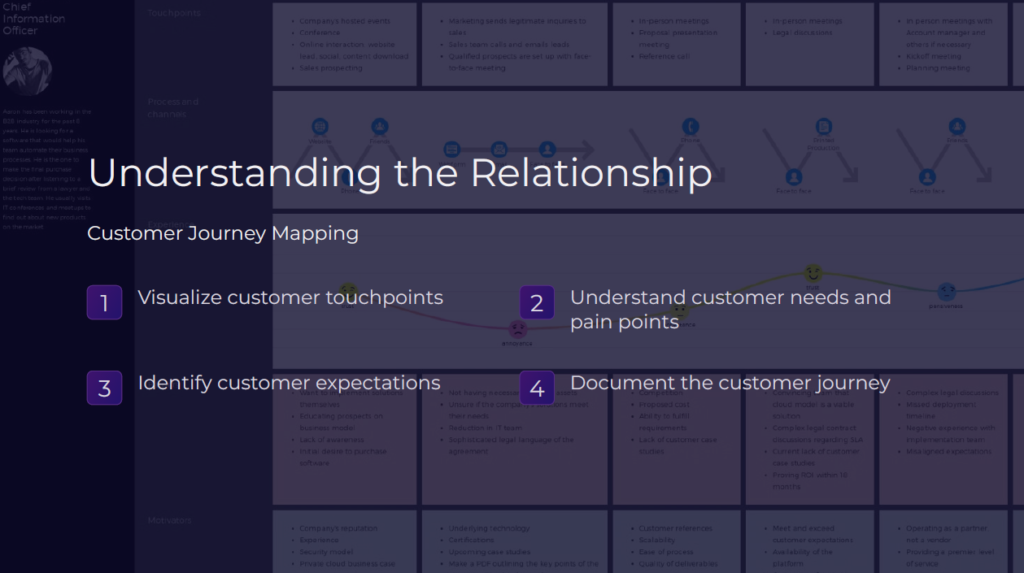
Before diving into process improvement, it is essential to consider the customer journey itself. The beauty of customer journey mapping lies in its ability to provide a clear visualization of all interactions with a customer, offering a comprehensive understanding of how customers, consumers, or patients interact throughout their entire experience. It's important to remember that the journey begins even before active engagement, such as when customers are considering contacting the business or searching for it online.
Examining marketing efforts, websites, and landing pages is also critical. Those play a significant role in how potential customers find and perceive the business. What they discover online can greatly influence their decision to reach out.
It is important to keep in mind the needs and pain points of customers. In performance improvement discussions, the focus often falls on internal operational issues like lack of staff, bottlenecks, and lengthy processes. While these internal challenges can indirectly affect the customer experience, the primary concern is usually internal. Shifting the perspective to understand the customer's experience and how improvements impact them is crucial.
Identifying customers' wants and expectations is essential. For instance, if a business claims to provide "red carpet service," it needs to ensure that this definition aligns with the customer's expectations. There can often be a gap between what is offered and what the customer perceives.
Customers frequently receive constant messages from various businesses about new sales, which can become overwhelming. Since this has become the norm, it is necessary to think about how to raise the bar and differentiate interactions with customers.
A journey map is a vital tool for documenting the customer experience. It provides a visual and documented reference that shows where the business is and where it is headed. This documentation is especially valuable when new team members join or when existing members switch roles, ensuring continuity and clarity in work and helping everyone stay aligned with goals and strategies.
The journey map also serves as an accessible and understandable history. New team members can quickly get up to speed with these visuals without having to read through extensive project documents repeatedly. The visual nature of the journey map is efficient for onboarding and communicating complex information quickly.
On the process improvement side, established frameworks like Six Sigma and Failure Modes and Effects Analysis (FMEA) are often used.
These frameworks help organize work and delve into the specifics of processes from an internal perspective. The advantage of these methodologies is their design to produce results. By following a structured approach, consistent improvements and desired outcomes can be achieved.
These methodologies have been successfully applied across various industries, including healthcare and financial services, proving their effectiveness over time.
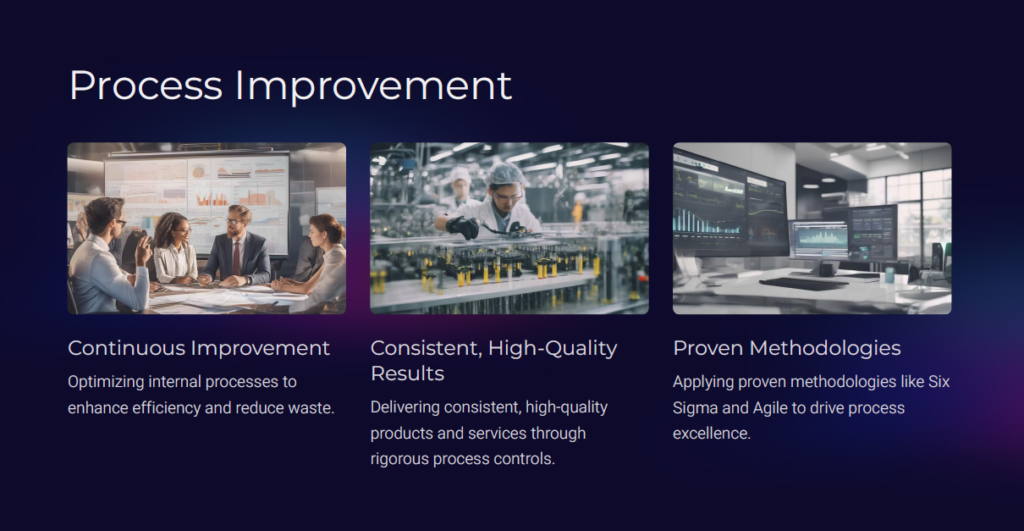
Aligning the journey with process improvement
Aligning the customer journey with process excellence ensures that internal processes are designed with the customer's experience in mind. For instance, in healthcare, the entire customer journey should be considered, from marketing to billing. The process doesn't end once treatment is completed; the billing experience is also a crucial part of the overall customer journey.
A great analogy is the Disney experience. At Disney World in Orlando, a guest can have a fantastic day but end up frustrated if they can't find their rental car in the vast parking lot. While this isn't technically Disney's problem, they recognize it as part of the guest experience. To address this, they ask guests what time they arrived and use that information to help locate their cars, ensuring a positive end to their visit. This shows how addressing even indirect aspects of the customer journey can enhance overall satisfaction.
The company wants to ensure a positive experience because a bad ending can ruin an otherwise great day. Imagine having a fantastic time at Disney, but then spending two hours in 90-degree heat trying to find your car. This can overshadow the entire visit.
Similarly, in healthcare, the billing process can be a major source of frustration. Patients often receive bills with no explanation, insurance modifications they don't understand, and multiple confusing statements. They may have to make several calls to get clarity, which detracts from their positive experience of receiving treatment and feeling better.
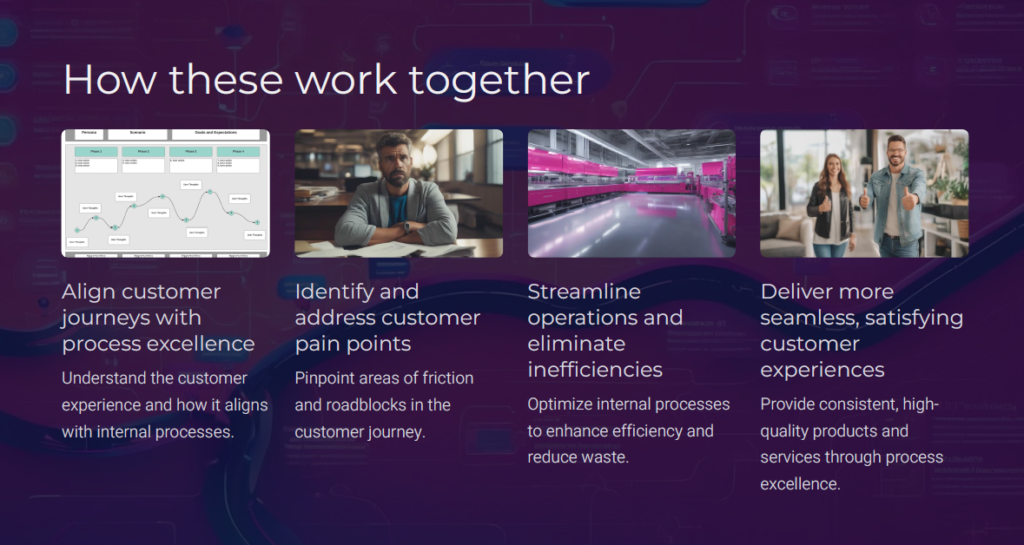
Identifying customer's pain points
Identifying and addressing customer pain points effectively is crucial. In healthcare, these pain points are not just about physical or mental discomfort but also about navigating a complex and confusing process. Patients may become frustrated and opt out of engaging further if their initial expectations are not met, such as when they sign up online and receive no follow-up or face lengthy and repetitive data collection procedures.
To bridge these gaps, streamlining operations and eliminating inefficiencies that negatively impact the customer is essential. While some issues are internal, the focus must remain on a customer- or patient-centric approach. The goal is to make interactions seamless and straightforward, ensuring customers do not feel confused or neglected.
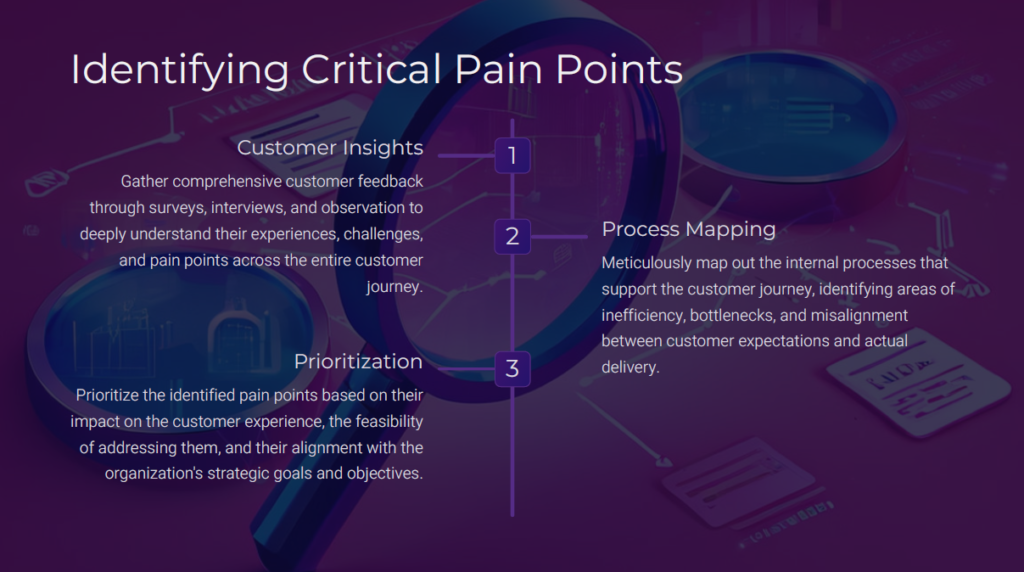
For example, in hospitals, patients are often asked their names multiple times by different shifts. While this is done for safety reasons, patients may find it frustrating if the purpose isn't explained to them. Setting clear expectations and providing explanations can significantly improve their experience. Ensuring customers understand the reasons behind certain procedures helps maintain their trust and satisfaction, aligning operational efficiency with customer journey excellence.
We do know who you are, but we have to double-check to ensure we're giving medications to the right person. There's a significant safety reason behind this practice, and it's essential to explain it to the patients.
When all these elements come together, they create a more seamless and satisfying customer experience. When patients understand why certain procedures are in place, they feel more comfortable and positive about their care. Even if they feel unwell, knowing that the process is designed to ensure their safety and improve their health can alleviate some of their stress.
Customer and patient insights are needed to effectively identify pain points. Patient satisfaction data is valuable for understanding both complaints and positive feedback. Celebrating teams that provide excellent service is important, but it's also crucial to make these positive experiences the norm rather than exceptions.
Understanding complaints is equally important. These can range from issues with finding the website to difficulties navigating it. So knowing the demographic and designing the website to meet their needs is vital. Sometimes there's a gap between who the website is designed for and who actually uses it, which can create confusion and frustration.
Meticulous process mapping is essential for identifying and addressing these issues. Detailed mapping helps understand exception handling and the volumes associated with it. When discussing processes with staff, it's important to investigate what they mean by exceptions. Is it something that happens daily or hourly? Understanding these nuances helps in creating more efficient and customer-friendly processes.
Having more data to support findings allows for a better understanding of the volumes going down different paths, enabling the customer experience to be built around that. For instance, exception handling might be necessary due to an insurer's requirements, which change the patient's experience. However, if the exceptions are caused by internal processes adding unnecessary steps, these can potentially be reduced.
These inefficiencies often arise around technology platforms. Off-the-shelf solutions may impose certain workflows that don’t make sense for specific needs. Customization with IT vendors is important, even if it delays development. The focus should always be on doing what’s right for the patient.
Combining these insights helps prioritize efforts. By understanding where pain points connect to processes, the focus can be on what matters most since it's impossible to fix everything at once. Prioritization is crucial, and tools like Failure Modes and Effects Analysis are great for this. FMEA helps track volumes, impacts, and frequencies, ensuring decisions are based on data rather than guesses. If data isn't available, it helps in estimating closely. This structured approach is similar to cybersecurity risk assessment tools, which focus on identifying and fixing threats.
Utilizing KPIs in your journey mapping projects
KPIs are the next crucial step. It's essential to measure what matters most and understand the impact of process changes. For every process change, identify the intended impact and target outcomes. This helps ensure that the changes not only meet internal goals but also enhance the customer experience.
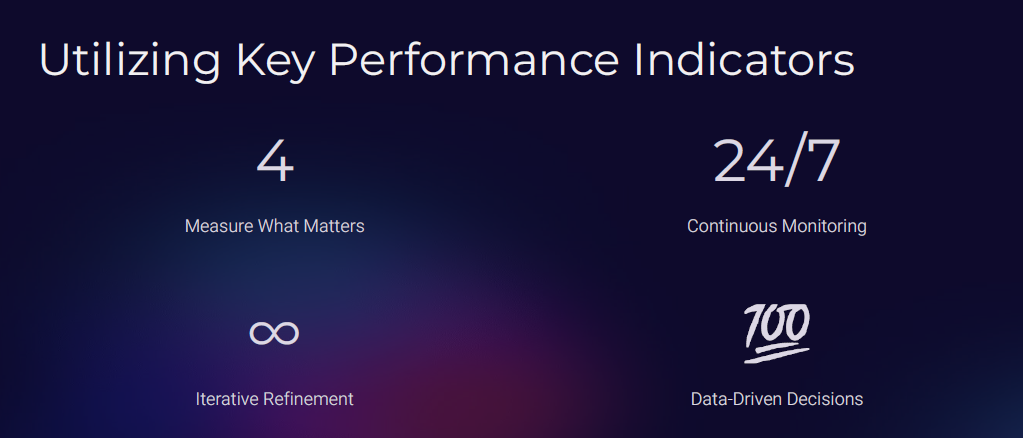
Setting KPIs during the project planning phase and carrying them forward until they consistently perform at the expected level over a long period is crucial. Regularly reviewing the relevancy of these KPIs, particularly in executive dashboards, ensures they remain meaningful. This continuous review helps avoid unnecessary KPIs that may no longer serve their original purpose, especially if data definitions have changed.
Continuous monitoring over time, rather than just for a few periods, is essential to understand if a process is in control or out of it. Recognizing seasonality in data is particularly important in healthcare, where certain times of the year can influence data patterns. For example, emergency room visits can increase during full moons or elective surgeries might decrease around holidays as people prefer to enjoy the holiday season.
Understanding these patterns requires running data through several cycles of seasonality to ensure that changes are effective and sustainable.
“Iterative refinement is key—always check if KPIs are still relevant and accurately measuring what they were intended to measure.”
If significant changes have occurred, some KPIs might become obsolete and should be removed or replaced with more relevant ones.
In healthcare, there is an abundance of data points. By combining customer journey mapping with process improvement, this data can be transformed into meaningful insights that accurately reflect what is happening in the system. This data-driven approach allows for more informed decision-making and better alignment of internal processes with the overall customer experience.
When referring to "system," it means the overall process, not just the computer systems that support it. The goal is to ensure decisions are data-driven rather than based on who complains the loudest.
In healthcare, the "squeaky wheel" phenomenon often occurs, where the loudest group or leader gets their way. However, decisions should be based on data. If the data supports their concerns, then they should indeed be prioritized, but this approach ensures focus on information rather than emotions.
Journey process
A journey process maps out each step a customer takes from initial awareness through post-purchase interactions, highlighting all touchpoints and experiences along the way. This process helps identify pain points and opportunities for improvement, ensuring a seamless and satisfying customer experience.
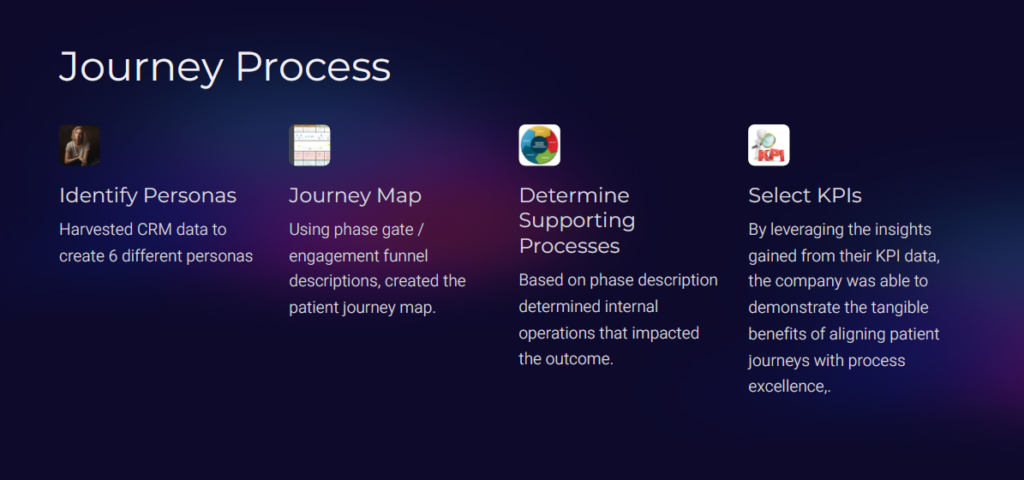
To illustrate this process, let’s consider a case example. The first step in the journey process is to identify personas. In a telehealth behavioral health situation, an organization uses their CRM data and discovers six distinct personas based on how patients were entering the system. For simplicity, let's focus on one persona in this example.
They created a journey map using phase gates and an engagement funnel. Similar to a sales funnel, this process had different decision points where patients could choose to continue their journey or drop out. This concept can be likened to a retail scenario where a customer might abandon a slow checkout line for a faster one. In healthcare, there's often an assumption that once patients start receiving treatment, they will continue regardless of their experience. However, patients do have the option to leave the treatment course.
The journey map highlighted the choices patients have at each decision point and the need to create a positive experience at every stage. Recognizing that patients can opt out emphasizes the importance of making each phase of their journey as smooth and satisfying as possible.
Next, the processes supporting each section of the journey were defined, and the relevant KPIs for those interactions were determined. In some cases, these KPIs were already being measured, while in others, the data existed but hadn't been used in that way. This part of the process is particularly exciting because it allows the use of data to fill out the story and create a comprehensive understanding of the customer's journey.
Example: Telehealth patient journey
Meet Robin, a self-referral persona.
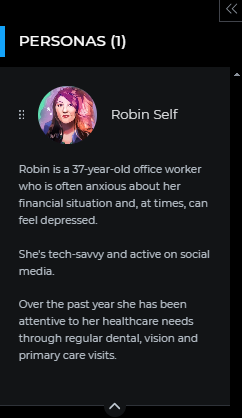
By analyzing her demographic data, insights into her age, occupation, concerns, and reasons for seeking services are gained. This insight is crucial because, across the six personas, the majority were female. However, the website initially featured images of older men in lab coats, which didn't resonate with the predominant demographic of female users seeking mental health services. This mismatch made the website feel uninviting to users like Robin.
And here’s her entire journey:
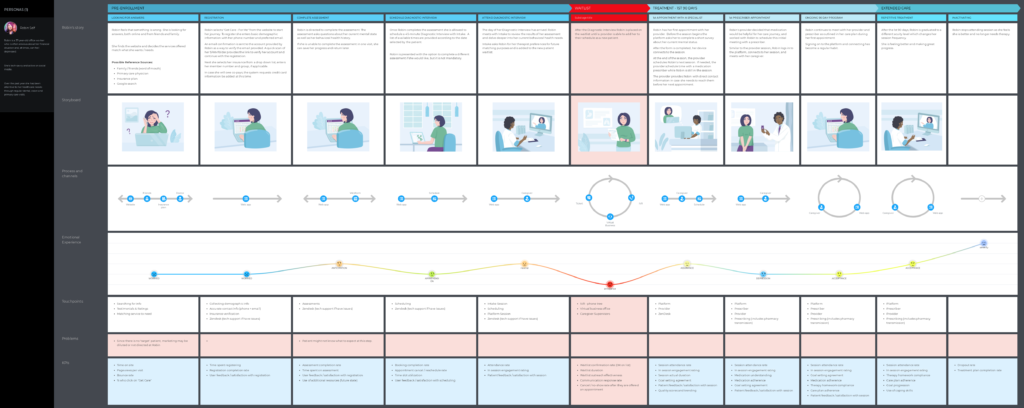
The different phases across the top can be seen, each with sub-phases leading into detailed interactions.
In this case, the story was written from the customer's perspective. This approach depends on how well the persona is developed and the amount of information available. Utilizing customer and patient surveys can provide additional insights.
For example, our persona, Robin, is looking for answers and doesn't know what to do. The storyboard visualizes her journey along with the processes and channels involved, tying everything together from a stakeholder perspective.

This method highlights her concerns and the steps she takes—checking the website, consulting friends, verifying insurance coverage, and seeking her physician's advice. At this stage, her emotional experience is characterized by worry.
The touchpoint section integrates internal processes, such as searching for information and reading testimonials and ratings on the website, which may or may not be helpful.

The next deep dive involves evaluating whether the service meets her needs based on what she finds online.
In Robin's case, the problem was a lack of a targeted patient profile, resulting in diluted marketing efforts. Despite substantial marketing spending, not targeting Robin—who represents 65% of incoming patients—meant missing a significant opportunity. The marketing funnel could be more effective by widening the top to pull in more potential patients if the experience were designed to connect with her needs.
KPIs to check at this stage include the time spent on the site, web views per visit, bounce rate, and the percentage of users following the CTA to "get care." It's important for website development to have a consistent and clear CTA. Avoiding multiple confusing options like "get care," "get more information," or "watch this video" ensures users know exactly what action to take. Here, the primary CTA should be "get care."
Once the initial interaction is clear and effective, Robin would proceed to registration, driven by her reason for seeking care. This step is critical in transitioning her from a website visitor to a registered patient, ensuring her needs are met and her journey continues smoothly.
Unfortunately, in this internal process, after Robin registered, she received an email to verify her address. While many people are accustomed to this verification step, some are not, and in this case, many of these emails ended up in spam folders. Consequently, Robin couldn't complete her registration, blocking her from accessing further services and causing frustration.
This user experience issue can be highly frustrating, especially if the user is already anxious. To mitigate this, it's important to measure KPIs such as time spent registering, registration completion rates, and user feedback satisfaction.
Once Robin managed to register, she needed to complete an assessment to provide more information about her situation. This step, still part of the online platform, involves web forms and possibly customer support if technical issues arise. Customer support becomes a critical touchpoint here, as users often need assistance to navigate technical difficulties.
The assessment process and subsequent interactions with tech support were identified as significant touchpoints. The patient's journey in a virtual setting heavily relies on the effectiveness of these touchpoints. For instance, the quality of the phone support, the responsiveness of the IVR system, and the clarity of the options presented all play crucial roles in the overall experience. A confusing or unresponsive system can lead to user frustration and may cause them to abandon the process altogether.
After completing the assessment, the next step was to schedule a diagnostic interview. In this interview, a healthcare provider would evaluate Robin and suggest a suitable treatment plan. This step is crucial in transitioning from the initial registration and assessment phases to receiving actual care.

To improve this process, it is vital to ensure seamless integration of all touchpoints and to continually refine and test the system based on user feedback and data. This involves regular monitoring and updating of the process to ensure it remains user-friendly and efficient, ultimately leading to better patient satisfaction and outcomes.
After completing the diagnostic interview, patients often found themselves placed on a waitlist, which became a point of contention. This waitlist was not part of the intended process but rather a result of current operational bottlenecks. While no one aims to have an extended waitlist, acknowledging its existence is crucial for understanding the customer's current experience. Addressing this bottleneck is a priority for process improvement, as it significantly impacts patient satisfaction.
An intentional waitlist, designed to manage specific preferences, is different from an accidental backlog resulting from inefficiencies. Although the organization was hesitant to include the waitlist in the journey map, accurately representing the current state is essential. Ignoring it would overlook a critical aspect of the customer's experience, which is vital for making meaningful improvements.
By aligning the customer journey map with process improvements, bottlenecks can be identified and alleviated, focusing on what matters most rather than trying to fix everything at once. This approach transforms the patient's experience and benefits the organization by improving operational efficiency and satisfaction.
Data-driven optimizations and process improvements are key. Utilize the data available to understand gaps and address them effectively. Sharing these insights with stakeholders through communication plans ensures that everyone understands the purpose and impact of these changes. This alignment should reflect positively in customer and patient satisfaction scores.
Wrapping up
Aligning journey mapping with process excellence is a powerful strategy for enhancing customer or patient experiences. It ensures that internal processes are customer-centric, leading to improved satisfaction, trust, and loyalty. By leveraging data, setting relevant KPIs, and continuously refining processes, organizations can achieve both operational efficiency and exceptional customer experiences. This holistic approach not only benefits the end-users but also drives the organization's success in a competitive landscape.
About the speaker

Brenda Batista-Mollohan, Founder of Inspiring Company Culture, is an accomplished entrepreneur and management consultant with over 25 years of experience driving performance improvement.
Her passion is applying systems engineering solutions to both individual and business challenges. She has successfully managed complex, multi-million dollar clients, developed computer simulations to predict business performance, and established scalable consulting methodologies that benefit both start-ups and established businesses alike.
Additionally, Brenda has significant experience in customer experience, further enhancing her ability to drive comprehensive improvements in various business contexts.


